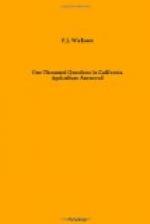Over-rank grain with abundant moisture will make a more stocky growth and stand against lodging if pastured or mowed. The leaves which you speak of as being lost in the later growth of the plant serve an important purpose in making that growth, and removing them is a repressive process which is not desirable when rain is short. We should allow the plants to push along into as good a growth of hay as a dry year’s moisture will give.
Dry Plowing for Grain.
We have land that we could very easily plow now with our traction engine and improved plows, but the people here claim that it does not pay to dry-plow, that is, before the land has had a good rain on it and the vegetation has started. I believe in dry plowing. Two of our oldest farmers in Merced county dry-plowed, that is, they commenced plowing as soon as harvesting was over.
If the rainfall is small and likely to come in light showers, dry plowing, if it turns up the land in large clods, might yield poorer results than land which is plowed after rain, because there would be so much moisture lost by drying out from the coarse surface when it came in amounts not adequate for deep penetration. Plowing after the rain for the purpose of killing out the foul stuff which starts is, however, quite another consideration. It is a fact that dry plowing and sowing is not now desirable in some places where it was formerly accepted, because the land has become so foul as to give a rank growth of weeds which choke out the grain at its beginning. Such land can be cleaned by one or two shallow plowings and cultivations after there is moisture enough to start the weeds to growing. These are local questions which you will have to settle by observation. In a general way, it is true that opening the surface of the ground before the rains, reduces the run-off and loss of moisture, but whether there would be any loss of moisture by run-off or not depends upon the slope of the land and also upon the way in which the rain comes, and the total amount of moisture which is available for the season.
Sub-varieties of California Barley.
Can you tell where I can buy seed of varieties of California six-rowed barley, described as “pallidum” and “coerulescens,” and what the seed will cost?
No one knows where the six-rowed barley, known as “common” barley in this State, came from, nor when it came. It has been here since the early days and it has naturally shown a disposition to vary, so that it is quite possible to select a number of types from any large field, of it. These variations have been studied to some extent by Eastern students who are endeavoring to develop American types of barley for brewing purposes as likely to be better than the brewing varieties which are famous in Europe. In Europe brewing barleys are chiefly two-rowed. Under California conditions the plant is able to develop just as good brewing grains on a six-rowed basis, and this seems to be a commendable trait in the way of multiplying the product. The names “pallidum” and “coerulescens” indicate two of these varieties recognized by Eastern students. It is not possible at this time to get even a pound of selected grain true to this type, and no one knows when it will be worked out to available quantities.




